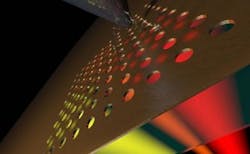| A metal nanocircuit is composed of an array of nanoscale holes in a 20-nm-thick gold film. A needle measures the voltage that is generated while the holes are illuminated. (Image: AMOLF) |
Researchers at the California Institute of Technology (Caltech; Pasadena, CA) and the FOM Institute AMOLF (Amsterdam, The Netherlands) have discovered a new way to convert light to an electrical potential using an all-metal geometry -- in contrast to the usual approach of optical excitation of semiconductors.1
In the new approach, the metal nanostructure consists either of arrays of gold (Au) nanoparticles on an indium tin oxide (ITO) substrate or of a rectangular array of 100-nm-diameter holes in a 20-nm-thick Au film deposited on a glass substrate.
The result for incident blue light at a wavelength below the plasmon resonance is a negative surface potential; for red light, which has a wavelength above the plasmon resonance, a positive surface potential arises. The electrical potential is as high as 100 mV at an illumination intensity of 100 mW/cm2. The voltage is measured using an ultrasensitive needle placed above the nanospheres while they are illuminated with laser light.
The Caltech and AMOLF researchers, who have been collaborators for many years, call the newly discovered effect the "plasmo-electric effect."
Origin is temperature variations
The researchers developed a thermodynamic model that describes the measured data well. The model shows that the incident light generates minute temperature variations that thermodynamically drive the exchange of electrical charges on the circuits, leading to the measured potentials.
Caltech researcher Harry Atwater, who led the study, says, "This work illustrates that electrical potentials can arise in metallic nanostructures in surprising ways. Although it is not clear how applications might develop from this finding, whenever you can design a optical material to produce potentials, it points toward possibilities for sensors and power converters."
Albert Polman, the leader of the AMOLF part of the team, notes, "This is an entirely new way to convert light into electricity. We have now shown that we can create a voltage; the next step is to see if we can also collect current and generate electrical power."
REFERENCE:
1. M. Sheldon et al., Science 346, published online October 30, 2014; doi: 10.1126/science.1258405
